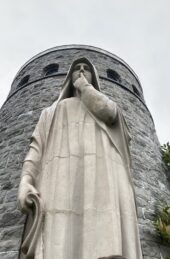As German tanks rolled over the border and occupied Poland on 1 September 1939, one of Britain’s most senior spymasters MI6 intelligence officer Thomas Joseph Kendrick arrived at the Tower of London. Within a special compound, away from the public eye, he opened a unit that would secretly bug the conversations of German prisoners of war in their rooms. Those prisoners were held in the historic Salt Tower, the Broad and Constable Towers and the old hospital block – interrogated but gave nothing away. Only when they returned to their comrades could they begin to boast about what they had not told the interrogators. They believed the British were unbelievably stupid and incompetent at interrogation. Little did they realise that the light fittings and thick stone fireplaces in the Tower had hidden microphones, wired back to an ‘M Room’ where secret listeners were recording their conversations. At the end of September 1939, Kendrick already had 60 German prisoners in the Tower, most of them U-boat crew captured after their U-boats had been sunk. Soon saw the arrival of shot-down Luftwaffe pilots and crews who began to open up to each other about their war, tactics, technology and ‘unbreakable’ codes.
So successful was the Tower’s clandestine operation proving for the intelligence war that Kendrick requisitioned the Trent Park estate at Cockfosters in North London. His team moved in to ‘wire it for sound’ and, under the auspices of the branch of military intelligence MI9, moved out there by the end of 1939. This hidden workforce of men and women would go on to amass nearly 75,000 thousands of transcripts of bugged conversations across the war – the content of which will begin to change and deepen our understanding of the Second World War as historians analyse the contents.
It was a tri-services unit of army, navy and air intelligence that soon became a massive intelligence-gathering factory that provided vital intel to Bletchley Park, MI5, MI6’s scientific section under Prof. R V Jones, Bomber Command, the Air Ministry and the Political Intelligence Department (to name a few). The volume of intelligence is staggering: from intelligence ahead of the Battle of Britain in 1940 and new enemy technology to night fighter strategy, new aircraft and fighting capability, U-boat operations and construction, German campaigns on the Russian front, detailed information on coastal defences, their construction and enemy operations ahead of D-Day and the Ardennes campaign, as well as details of mass atrocities and concentration camps.
Then within two weeks of the bombing of Pearl harbour in December 1941, American intelligence officers arrived at Trent Park. They were from the Office for Strategic Services (OSS, later CIA) and went on to make a valuable contribution as interrogators and intelligence officers. Their work marked the close emerging Anglo-American intelligence cooperation that still continues today.
In 1941/2 Kendrick expanded and requisitioned two further country estates in Buckinghamshire: Latimer House and Wilton Park. They would process 10,000 lower rank enemy prisoners of war. With increased personnel to 1,000, the sites had teams of German-Jewish refugee secret listeners recording, translating and transcribing the conversations, and women carrying out crucial intelligence analysis and even interrogation.
Meanwhile Trent Park was finally reserved for the most prized prisoners of all – Hitler’s captured Generals and commanders. In May 1943 General von Arnim arrived with his entourage and senior officers from the battlefields of North Africa having surrendered with 350,000 men. After D-Day, all the high ranking German commanders – Generals and two Field Marshals – arrived in stages at Trent Park. Whilst they were wined and dined, looked after by a fake aristocrat ‘Lord Aberfeldy’, taken on trips to Simpsons on the Strand and given copious supplies of gin at the Ritz, they were totally hood-winked. Kendrick had already arranged for the house to be further ‘wired for sound’ – with microphones embedded in the walls, under floorboards, deep in and behind fireplaces, in plant pots and the billiards table. Even the trees in the garden were bugged to record the Generals on their walks around the grounds. Not a single snippet of information could be missed.
The frivolity and outlandish treatment of the Generals had one aim – to win the intelligence war. Giving 59 German generals and nearly 40 senior German officers a life of relative luxury in the mansion house arguably led to one of the greatest intelligence coups of the war. From the bugged conversations of commanders most trusted by Hitler to protect Germany’s secrets, the Allies gained the first concrete proof at Trent Park of Hitler’s secret weapon programme at Peenemünde on the Baltic coast (i.e. V-1, V-2 and V-3). It led directly to the bombing of Peenemünde in August 1943 in Operation Crossbow on the orders of Prime Minister Winston Churchill.
It would be 65 years before any whisper of these secrets came out as the files were finally released into the National Archives. The majority of the intelligence officers and secret listeners had passed way by then and had never told their families what they had done. They had signed the Official Secrets Acts and could not breathe a word to anyone.
The ‘theatrical stage set’ that the Generals walked into at Trent Park could not have been created better as fiction. Fortunately, the ‘mad hatters tea party’ of daily life at Trent Park has been recorded in the weekly intelligence reports and the transcripts of conversations for posterity. These preserve rare real conversations of the war and an unprecedentedly unique snapshot into daily life in the Second World War. And therein lies the extraordinary gem. This was no fiction, but one of the greatest deceptions against Nazi Germany of the Second World War. In February 2017 Historic England formally concluded that Trent Park’s wartime work was ‘of considerable national and international historical interest which bears comparison to the code-breaking work at Bletchley Park.’






